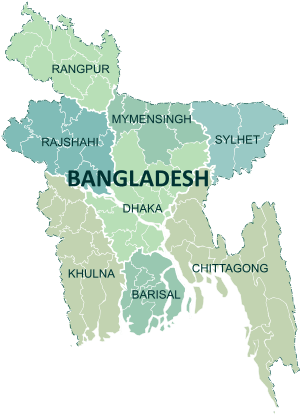Manikganj District
| Manikganj মানিকগঞ্জ | |
|---|---|
| District | |
 Location of Manikganj in Bangladesh | |
| Coordinates: BD 23°51′N 90°01′E / 23.85°N 90.01°ECoordinates: BD 23°51′N 90°01′E / 23.85°N 90.01°E | |
| Country |
|
| Division | Dhaka Division |
| Area | |
| • Total | 1,383.66 km2 (534.23 sq mi) |
| Population (2011 census) | |
| • Total | 1,392,867 |
| • Density | 1,000/km2 (2,600/sq mi) |
| Literacy rate | |
| • Total | 26.9% |
| Time zone | BST (UTC+6) |
| Postal code | 1800 |
| Website |
www |
Manikganj (Bengali: মানিকগঞ্জ [mɑnɪkˈɡondʒ]) is a district in central Bangladesh. It is a part of the Dhaka Division.[1]
History
Manikganj was formerly a subdivision of Dhaka District. It was turned into a district in 1984.
On 26 April 1989, Manikganj was the site of, what was at that time, the world's worst tornado in terms of loss-of-lives. 1,300 people were initially reported as having been killed with 12,000 injured. The towns of Saturia and Manikganj Sadar were leveled and about 80,000 people were made homeless.
War of Liberation
Liberation war in 1971 in Manikganj District was organized and led by Capt. Halim Chowdhury, Abdul Matin Chowdhury, Principal Abdur Rouf Khan and other heroes of the district.
During November 1971, at the Northwest corner of Golaidanga village, Balodhara union in Singair upazila, a group of Freedom Fighters attacked the boats carrying the Pakistani intruding soldiers and a terrible battle occurred on the Nuraniganga Khal (canal). Eighty-two Pak soldiers were killed and 50 others held with injuries in a fierce battle with freedom fighters at Golaidanga village in Singair upazila on October 28. Freedom fighters Lokman Hossain, Zahidur Rahman and Tobarak Hossain Ludu led the operation. More than three hundred Mukti Bahini Freedom Fighters were killed during this battle which is one of the significant liberation fight against Pakistani military in Manikgonj. After this battle, the PAK soldiers burnt 152 houses surrounding villages of the battle place and killed 6 local people who were mostly elderly stayed at home. In the last week of November in 1971, fresh groups of freedom fighters entered different areas of Manikganj and defeated Pakistani troops in a few battles. Finally they declared the then sub-division (now Manikganj district) free on December 13.
Geography
Manikganj is a district in Dhaka Division. It comprises an area of 1,383.66 km2 (534.23 sq mi). Annual average temperatures reach a maximum of 36 °C and a minimum to 12.7 °C with the annual rainfall total being 2,376 mm (93.5 in).
Population
Manikganj District has a population of 1,274,829; 51.16% male and 48.84% female; the population density is 2582.
Economy
There are total 166 Haats and Bazars.. Besides 54 fairs (Mela) are held in Manikgonj. Manikgonj bijoy Mela,Zinda baba mela jhitka Rowth Jattra Mela (Katigram) Poush mela (Atigram), Bathaimuri Mela, Baher Paglar Mela (BANGALA), Baher paglar mela (Mohadebpur) Sadhur Mela ( South Jamsha,Singair), sadhinotar mela (Maluchi) are favorite all over Manikgonj.Barangail Bazar, Baira Bazar, Jhitka Bazar, Gheor Bazar, Singair Bazar, Bangala Bazar, Maluchi Bazar (Balla bazar) are famous bazar in manikganj.
Places of interest
- Baliati Zamindari Home,
.jpg)
-

Baliati Palace
-

Baliati Palace
-

Baliati Palace - backside
- Teota Jamindar Bari.
Subdivisions
The upazillas are
- Manikganj Sadar Upazila,
- Singair Upazila,
- Shivalaya Upazila,
- Saturia Upazila,
- Harirampur Upazila,
- Ghior Upazila and
- Daulatpur Upazila.
Religion
The district of Manikganj has 3575 mosques, 160 temples, 10 churches, five Buddhist temples and a pagoda.
Rivers
There are quite a few rivers in the Manikganj District.[2] The names of the some important rivers of this district are as follows:
- The Padma
- The Kaliganga
- The Jamuna
- The Dhaleshwari
- The Ichamati
Educational institutions
- Government Debendra CollegeGovernment Debendra College, Manikgonj
- Motilal Degree College, Daulatpur, Manikganj
- Jhitka Khawja Rahmat Ali College
- Manikganj Govt. High School
- Manikganj Medical College
- S.K. Govt. Girls High School Manikgonj
- Baliati Iswar Chandra High School
- Government Textile Vocational Institute Manikganj
- Golaidanga High School
Sports
Manikganj Stadium is located by the Manikganj public library, Manikganj, Bangladesh
Notable residents
- Amartya Sen, economist
- Rofique Uddin Ahmed, Vasha Shaheed
- Hiralal Sen, filmmaker
- Dinesh Chandra Sen, writer
- Sourav Ganguly father's home is in Dankora, Saturia, Manikganj
- Momtaz Begum singer, Manikganj
- Shamsul Islam Khan (Ex- Minister ministry of Industry).
- Khan Ataur Rahman, Music Director, Filmmaker, Actor
- Munir Chowdhury, Educator, Dramatist and a martyr of Bangladesh War of Independence, was born in Manikganj.
See also
References
| Wikimedia Commons has media related to Manikganj District. |
- ↑ Suruj Khan (2012). "Manikganj District". In Sirajul Islam and Ahmed A. Jamal. Banglapedia: National Encyclopedia of Bangladesh (Second ed.). Asiatic Society of Bangladesh.
- ↑ Bangladesh District Gazetteers:Manikganj. Government of Bangladesh. 1979, pp. 2–8
